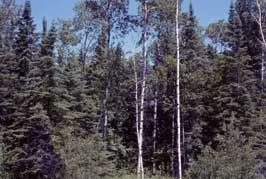Brule River Boreal Forest
No. 160

Photo by E. Epstein
Situated along the steep slopes and terraces bordering the Brule River is a boreal forest in various stages of recovery. The most mature stands feature large, white pine, white spruce, balsam fir, balsam poplar, and occasionally white cedar on the slopes. White spruce is reproducing well. The younger stands are generally aspen-dominated with paper birch being a significant component of more disturbed stands. Shrubs include alder, northern bush honeysuckle, early low blueberry, and round-leaved dogwood. Characteristic herbs are large-leaved aster, wild sarsaparilla, twinflower, lady fern, bracken fern, wild strawberry,
American starflower, and Canada mayflower. Noteworthy plants found within the boreal forest include rabbit-berry and purple clematis (Clematis occidentalis). Terraces along this stretch of river support swamp hardwood stand composed of black ash and red maple, alder thicket, and stands of emergent marsh in old abandoned oxbows. In a steep-sided ravine along a tributary to the Brule is a mature forest of large to medium white spruce and balsam fir.
Understory plants include wood anemones, dwarf red raspberry, bunchberry, and hairy wood rush. Small spring areas along the creek drain the ravine and support chestnut sedge, sprengel's sedge, Michigan lily, and rabbit berry. Resident birds are black-throated green, pine, and Nashville warblers, ovenbird, and hermit thrush. Brule River Boreal Forest is owned by the DNR and was designated a State Natural Area in 2003.
Very few State Natural Areas have public facilities, but nearly all are open for a variety of recreational activities as indicated below. Generally, there are no picnic areas, restrooms, or other developments. Parking lots or designated parking areas are noted on individual SNA pages and maps. Trails, if present, are typically undesignated footpaths. If a developed trail is present, it will normally be noted on the SNA map under the Maps tab. A compass and topographic map or a GPS unit are useful tools for exploring larger, isolated SNAs.
The good majority of SNAs are isolated and have few or no facilities. Some SNAs have vehicle access lanes or parking lots, but their accessibility may vary depending on weather conditions. Parking lots and lanes are not plowed during winter. Hiking trails may be nonexistent or consist of undeveloped footpaths. A GPS unit or compass and a detailed topographic map are useful tools for exploring larger SNAs.
Entrance fees: Except for Parfrey's Glen, the Cambrian Outlook in the Dells of the Wisconsin River, SNAs within State Parks and some within State Forests, all other DNR-owned SNAs do not have any admission fees. For more information, see Wis. Admin. Code NR 45. For non-DNR-owned SNAs, we are unaware of any vehicle or admission fees. However, please contact the landowner for more information.
Allowable activities: DNR-owned land
The activities listed below are generally allowed on all DNR-owned SNA lands. Exceptions to this list of public uses, such as SNAs closed to hunting, are noted above and posted with signs on the property site.
- Hiking
- Fishing
- Cross country skiing
- Hunting
- Trapping
- Scientific research (permit required)
- Outdoor education
- Wild edibles (What is this?)
- Pets (Rules)
- Wildlife viewing
Prohibited activities: all SNAs
- Camping and campfires
- Collecting of animals (other than legally harvested species), non-edible fungi, rocks, minerals, fossils, archaeological artifacts, soil, downed wood, or any other natural material alive or dead.
- Collecting for scientific research requires a permit issued by the DNR
- Collecting of plants including seeds, roots or other non-edible parts of herbaceous plants such as wildflowers or grasses
- Geocaching
- Horseback riding
- Rock climbing
- Vehicles, including bicycles, ATVs, aircraft, and snowmobiles except on trails and roadways designated for their use.
For rules governing state-owned SNAs and other state lands, please consult Chapter NR 45 Wis. Admin. Code [exit DNR].
Location
Within the Brule River State Forest, Douglas County. T49N-R10W, Sections 10, 15, 22, 23, 27. 652 acres.
Driving directions
The area is best seen by canoe. Put in at Highway 13 canoe landing and canoe downstream through the natural area. Walk-in access is available from numerous parking areas located along Brule River Road - north and west of Highway 13.
The DNR's state natural areas program is comprised of lands owned by the state, private conservation organizations, municipalities, other governmental agencies, educational institutions, and private individuals. While the majority of SNAs are open to the public, access may vary according to individual ownership policies. Public use restrictions may apply due to public safety, or to protect endangered or threatened species or unique natural features. Lands may be temporarily closed due to specific management activities.
Users are encouraged to contact the landowner for more specific details. The data shown on these maps have been obtained from various sources, and are of varying age, reliability, and resolution. The data may contain errors or omissions and should not be interpreted as a legal representation of legal ownership boundaries. To create your custom map where you can zoom to a specific location, please use the DNR's Mapping Application.
Brule River Boreal Forest is owned by: Wisconsin DNR
Management objectives and prescriptions
Read the Brule River Master Plan for details.
